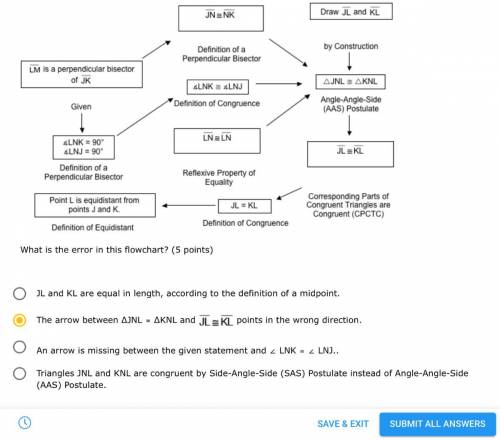
Mathematics, 22.04.2020 02:25 dctjr
The following is an incorrect flowchart proving that point L, lying on line LM which is a perpendicular bisector of segment JK , is equidistant from points J and K:
Segment JK intersects line LM at point N
Line LM is a perpendicular bisector of segment JK, Given. Two arrows are drawn from this statement to the following two stateme
What is the error in this flowchart? (5 points)
JL and KL are equal in length, according to the definition of a midpoint.
The arrow between ΔJNL ≅ ΔKNL and segment J L is congruent to segment K L points in the wrong direction.
An arrow is missing between the given statement and ∠ LNK ≅ ∠ LNJ..
Triangles JNL and KNL are congruent by Side-Angle-Side (SAS) Postulate instead of Angle-Angle-Side (AAS) Postulate.


Answers: 2


Another question on Mathematics

Mathematics, 21.06.2019 15:30
Strawberries cause two hours per pound kate buys 5 pounds he gets 20% off discount on the total cost how much does kate pay for the strawberries
Answers: 3



Mathematics, 21.06.2019 21:40
Write the contrapositive of the conditional statement. determine whether the contrapositive is true or false. if it is false, find a counterexample. a converse statement is formed by exchanging the hypothesis and conclusion of the conditional. a) a non-converse statement is not formed by exchanging the hypothesis and conclusion of the conditional. true b) a statement not formed by exchanging the hypothesis and conclusion of the conditional is a converse statement. false; an inverse statement is not formed by exchanging the hypothesis and conclusion of the conditional. c) a non-converse statement is formed by exchanging the hypothesis and conclusion of the conditional. false; an inverse statement is formed by negating both the hypothesis and conclusion of the conditional. d) a statement not formed by exchanging the hypothesis and conclusion of the conditional is not a converse statement. true
Answers: 1
You know the right answer?
The following is an incorrect flowchart proving that point L, lying on line LM which is a perpendicu...
Questions


English, 03.12.2021 22:50






Mathematics, 03.12.2021 22:50


English, 03.12.2021 22:50

Mathematics, 03.12.2021 22:50

Social Studies, 03.12.2021 22:50








Mathematics, 03.12.2021 22:50



